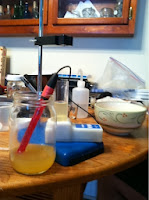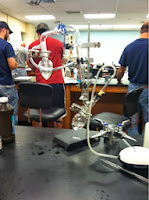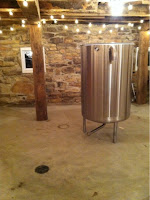About two weeks we added yeast to our apple cider, which was fermenting in the barn. We checked the progress for the first few days and it seemed ok, but then we got sidetracked with the new baby, and sort of forgot about the fermenting apple cider.
 We finally went out to check on it yesterday, thinking that fermentation should be completed. But the temperature in the barn had dropped enough during the last week to stop the yeast from growing further. Luckily, the cider was not spoiled, it had a slight alcohol taste – enough to keep it from spoiling – but it was still really, really sweet (at 19° Brix).
We finally went out to check on it yesterday, thinking that fermentation should be completed. But the temperature in the barn had dropped enough during the last week to stop the yeast from growing further. Luckily, the cider was not spoiled, it had a slight alcohol taste – enough to keep it from spoiling – but it was still really, really sweet (at 19° Brix).
Jeff racked the cider into carboys and brought them into the kitchen. Once they warmed up – which took all night – the yeasts “went to town”. Each carboy looks like it is boiling from all the fermentation activity and the airlocks are just bubbling. It sounds like there is water running in the kitchen.












